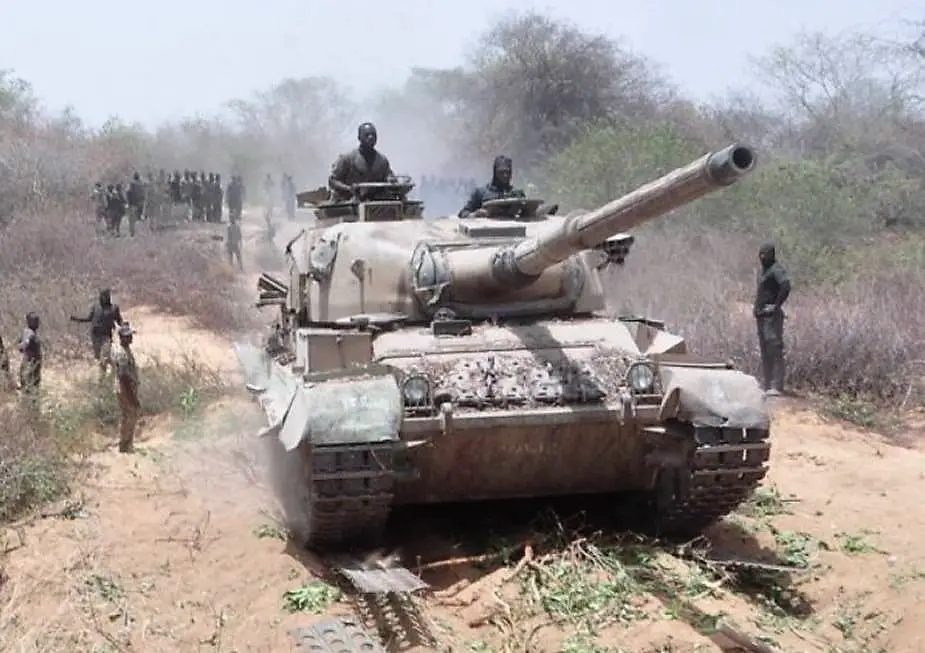Breaking news
Nigerian army old Vickers Mk3 MBTs more reliable than recent T-72M MBTs.
According to a tweet from Defense News Nigeria, the British-built Vickers Mk.3 Eagle tank acquired over 30 years ago has proven to be a far more reliable tank on the battlefield, with fewer breakdowns than the T-72 tanks acquired in 2014-2015.
Follow Army Recognition on Google News at this link

Nigerian Army T-72AV main battle tank (Picture source: Twitter/beegeaglesblog)
To be fair, another tweet writes that those T-72s were old purchased as new that time from the black market with no spares. Others had to be cannibalized to fix broken ones. Nigeria acquired a mix of T-72A, T-72AV, T-72M1, and T-72B from Hungary, Czech, and Ukraine in 2014-15 during the start of the terror insurgency in the northeast. The t-72 B model was acquired from Ukraine in 2014, and the T-72M1 was acquired from the Czech Republic in 2015. The total price of the delivery was estimated at USD8m (N1,536,400,000), with a unit price per tank of $8 million, Africa Defense News reports. The Nigerian Army keeps fixing some of these dilapidated T-72s. At least 25 T-72s have been refitted and readied for combat operations across various theaters, and a subsequent batch will also be repaired and brought to fighting condition.
According to Military Africa, through the Czech company Excalibur Army, Hungarian T-72As and T-72M1s were sold to Nigeria. 16 T-72M1 tanks, BMP armored infantry fighting vehicles, and rocket launchers were shipped to Nigeria on board the huge Ukrainian An-225 Mriya freighter, which would be destroyed in its hangar in late February 2022 by the Russian invaders. The first batch of four tanks took off from the Ostrava airfield on 26th January on board of the An-225 Mriya (number UR-82060). Before the departure, the vehicles undertook service in one of the Excalibur Group’s facilities (probably VOP 026 Šternberk). Nigeria also signed a contract for T-72AW tanks with Ukraine in 2014 but, probably due to the civil war in Nigeria at the time, the tanks were embargoed.
Military Africa recalls that at the time of their delivery and deployment, the T-72 tanks were responsible for the success of the counter-terrorism operations at the time, particularly in Michika, Gwoza, and Madagali. At the start of the new offensive, the rehabilitated T-72s will operate alongside the newly acquired Chinese VT-4 main battle tank, ST-1 gun support vehicle, and Norinco Type-89 tracked armored vehicles.
Commenting, Boboye Adeolu, a Nigerian defense analyst opined that the Nigerian Army “seems not to be leaving anything to chance this time and with those reactivated T-72s it might be possible to see ST-1s at the head of logistics movements followed by MRAPs and Mengshi, it would be interesting to see ISWAP trying to ambush such well-defended logistic trains..”

The Vickers Mk.3N is the Mark 3 used by the Nigerian Army, known locally as "Eagle" (Picture source: Twitter account of Defense News Africa)
The Vickers Mk. 3 was a development of the Vickers MBT and introduced in 1975 for the export market. It was the last of the Vickers tanks to see sales in numbers abroad. The Mk.3N is the Mark 3 used by the Nigerian Army, known locally as "Eagle". It is fitted with a solid thermal shroud around its gun barrel and uses a Nanoquest L23 gunner sight featuring a Simrad LV352 laser rangefinder.
The Mk. 3 retains most of the proposed features of the Mk. 2. Others were the provision for infrared/white-light searchlights and the abandonment of flotation gear. A laser rangefinder of the type being fitted to the Chieftain was also proposed since the range of the L7 105 mm gun was well beyond that of the 12.7 mm ranging machine gun fitted. Some thought was also given to the idea of mounting the heavier British L11 120 mm gun on the Vickers tank, but this was abandoned because the 105 mm L7-series rifled gun was becoming the NATO standard, 120 mm ammunition was more expensive than 105 mm and was used only by the British Army in Europe, and the weight advantage of the Vicker's tank would be reduced.




























